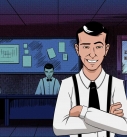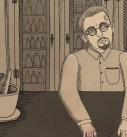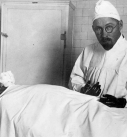In her documentaries, Penny Lane* turns realism on its ear
“A door will open that had always been closed to you: a door to a new dimension in your awareness of the nature of life.”
This line from Professor Penny Lane’s newest documentary, Just Add Water, is about Sea-Monkeys (yes, you read that right), but it could also describe Lane’s work.
For example, Just Add Water starts out as a cheerful chronicle of Harold von Braunhut and his inventions, which included the Amazing Sea-Monkeys, X-Ray Specs, and other novelties that were advertised in comic books in the ’60s and ’70s. But the movie changes tone when von Braunhut’s dark secret is revealed.
As the voiceover of von Braunhut says in the movie, “People are complicated. Life is complicated.”
That theme also occurs in Lane’s two feature films. With Our Nixon (2013), “I made a movie about Richard Nixon’s aides that asked to have empathy for them, not because they were good guys who did good stuff, but because they’re people!” she told Paste magazine last summer. “They are human beings.” Likewise, NUTS! (2016) told the story of “goat-gland doctor” John Romulus Brinkley. She said, “Brinkley had a lot of bad aspects of humanity … but I also do believe that he was trying to build a better life for his son. He’s a person. I don’t think it’s controversial to ask people to feel empathy for even really bad people, you know?”
Whether she’s focusing on questionable characters, a cosmic love story (The Voyagers, 2010), or Emily Dickinson (The Wren, 2007), Lane presents the complex tapestries that make us human.
Lane came to Colgate in 2013 and released Our Nixon shortly after. Called “ingenious” by New York Times critic A.O. Scott and a “must-see” by Variety, the film came under fire by pundit Ben Stein for being misrepresentative. In Our Nixon and her other films, Lane uses creative license in the editing and storytelling processes, which her critics claim blurs the lines of a documentary.
For example, in NUTS!, a wild ride of a film about a charlatan, Lane herself “cons” the audience. “The con man operates the same way as a documentary filmmaker does, on a scale,” she told Paste. “You’re taking little pieces of the truth and you’re wrapping them up in a story, and there’s an inherently fictionalized aspect of any story.”
“The best works of art nearly always do what Penny Lane does. They unsettle us.”
– English professor Jennifer Brice at the NUTS! Hamilton showing
Lane is now working on a documentary about Nellie Bly, the pioneering 19th- century journalist, for The Center for Investigative Reporting. The difficulty with this film, Lane explained, is trying to learn who Bly was beyond the factual information available. “Nellie Bly is a feminist icon,” Lane said. “[But] it’s very telling that all the books about her are for children, because that’s the level of understanding we have of who she was. So I’m reading all of her writing and trying to find something about her voice.” The lack of visual assets also presents a hurdle with historical subjects like Bly — as with Brinkley and von Braunhut. “I have a great knack for picking stories from history for which there are no moving images,” Lane joked.
Her colleagues would argue that this is part of what’s earned her recognition. “[She] is on the cutting edge in terms of combining archival images, sound recordings, animation by many different animators, using a lot of strategies to fill in when there is no visual documentation,” Jaime Baron, a film studies professor at the University of Alberta, told Ozy.com. Cinefiles and film professionals alike have become fascinated with Lane and her work — to the point where she herself has become a character study. In the interview that follows, originally published in Slant magazine, Lane talks more about how she approaches filmmaking.
— Aleta Mayne
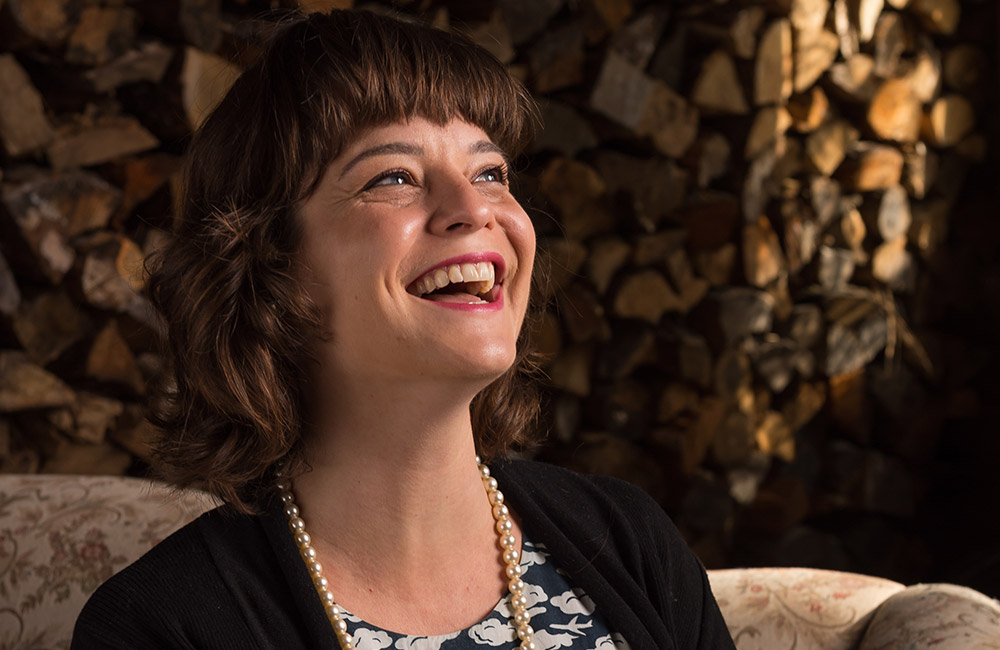
Q&A
With Penny Lane, art and art history professor
*Not to be confused with:
Penny Lane, a groupie.
Penny Lane, a Beatles song.
Penny Lake, a street in England.
From her website, pennylaneismyrealname.com
Let’s get the name out of the way. Were your parents hippies?
No. They were just teenagers with the last name Lane. It wasn’t that thought out. Lois Lane was another option, so all I can do is be happy that they didn’t go with [that].
Your movies aren’t quite documentaries in the traditional sense. How do you describe your work?
This is what I think about all the time. I went to art school and studied video art and experimental film. Then I started making things that seemed more like documentaries than experimental film, but I’m still a little bit between those two idioms. It’s, like, experimental in the mainstream doc world, but in the experimental film world, it’s accessible. I like to be on the periphery.
My role model is Banksy, who made Exit Through the Gift Shop, which is a profoundly influential film on me. That film achieved something that I knew I wanted to do as a filmmaker, but had never really seen, which was to make an accessible, funny, entertaining movie that was also film-nerd catnip. It was formally so strange and out there that to this day I’m still having arguments with people about whether this edit was a lie or not, or whether Banksy exists. It also has lots of ideas in it, but if you’re just going to be a casual film viewer, you can just enjoy the movie as a movie. That gave me hope, because I had it in my head that I wanted to do that.
You seem like someone who’s pursued what you love from an early age.
I’ve always been pretty good at inventing my own life and coming up with my own path through it, but the filmmaking stuff didn’t start until I was a little older. I started making video art when I was about 22 or 23. It actually feels very gradual and slow. Hopefully it’ll keep changing the same way, where 10 years from now I’ll look back and see how it all relates, but what I’m doing then will be something totally different than what I’m doing now.
How have you made the money part work?
[As a] professor, I’ve never had to be a professional filmmaker. And I have a salary, so I can take risks. It turns out that the two features that I’ve made have been financially successful, but that was a surprise. Our Nixon, I thought, was totally weird. I thought no one would get it. And [Nuts!], I thought, was so much weirder. It was very hard to explain it, and it’s very hard to pitch it. In the process of making it, I didn’t feel like the whole world was [saying], “You have to make this film.” Most of that had to come from me. It was very hard to maintain the energy to keep it going and get it done.
So much of your work is created with archival footage. I read in one of your interviews that you hate to point a camera at people, so I’m wondering: How much do you use archival footage because of that and how much is it because there’s something you love about the discovery process of going through old footage — or finding good source material of other kinds?
It’s all of that. It’s my reticence to point cameras at people. And, as an artist, you choose your challenges, and for whatever reason, negotiating access to a subject isn’t a challenge that I want to be staying up at night worrying about. Figuring out how to take a pile of old ads and turn it into a movie is more interesting to me. Or maybe I’m a little more comfortable in it. I’m a little bit of a control freak, so being alone in my house without having to negotiate all that stuff feels really good. Doing archival research is like what most of my peers do when they go out and film. You’re discovering, and it’s beautiful and exciting. You have to keep an open mind but at the same time keep an eye on your plan. Because you can get very lost in an archive, but also you should be open to something showing up and entering the picture that you weren’t looking for. So it’s really not that different.
One of the things NUTS! is about is how to think critically while watching a movie. You’re challenging your viewers to question what is and isn’t true.
Absolutely! People don’t always get that documentaries have a director. They have no idea that these movies are contingent on who’s making it, what questions they ask, what materials are available to them at the moment that they asked it, what happened in the edit room, their mood that day. With this film I wanted to make it as clear as possible that Penny Lane is a person, and she has made choices. To the point where you see my hands, literally, moving the archival material around in one scene.
And if you watch the film with attention — which not everyone will, which is fine — you’ll definitely think, by the end: “Well, wait a minute! Didn’t she tell me this? And was that not true?” That kind of feeling, I think, can be really productive. Which is why I think the true crime genre is actually quite good for documentary. Making a Murderer. The Jinx. Serial. Audiences get very engaged in researching the subject and saying, “Wait a minute! They left this out,” because we’re trying to solve the murder or whatever. It’s the one area where I see where the general public does get very invested in questions like authorial intent and editing and shaping.
Goats keep popping up like Waldo in the animated sequences in NUTS! Is that something you told all your animators that you wanted?
Yeah. I wanted some goat cameos. That was definitely part of the instructions. This is another thing we couldn’t have anticipated: We didn’t know goats were going to become cool. Chickens were cool when I started the movie, and now chickens are totally out and goats are what’s cool. So I was, like, we’ve gotta put more goats in the movie. I’m kidding.
But no, I always had this idea that Brinkley had a crowd of fans around him, even if you couldn’t see them. His wife was always standing next to him, and nearby would be his supporters, and there would always be a goat there. We just thought that would be funny.
The thing about animation is that you can do a lot of things that would be cost-prohibitive if you were shooting them. Like, you can make a plane explode. Doesn’t cost any more dollars than to not have the plane explode. I tried to take advantage of that, so we could have big set pieces at a party or dream sequences or these really fantastical elements. Those are mostly dialed down, because it’s a documentary and they need to somewhat read as real for the movie to work. But we did try to take advantage of at least some gags.
Is the animation why it took so long to make NUTS!?
Oh, absolutely. The movie was basically done two years ago, but with no pictures where pictures need to be. It was very frustrating. I want to keep making films the way I’d been doing it at least sometimes, which is having complete freedom and no [financial] support. I think it’s worked out pretty well for me so far, doing it that way. I’m a little worried about what will happen if I don’t make them that way. And I’ve vowed to myself that I’ll never make a film again where the engine of the film is something that I cannot do myself.
The Voyagers is my favorite of your films. I read somewhere that it was your favorite, too. Is it still?
Oh yeah. It’s the best thing that I ever made. It’s because I made it for one person. Frank O’Hara wrote a quasi-joke of a manifesto called Personism, where he talks about how poets should only address a poem to one person because this will remove all the artifacts and will make it really about this active communication that we say it is, but really it’s [usually] more about posturing. I made that film for my then-fiancé to show at my wedding, with no intention of ever showing it to anyone else, ever again. This was a gift for one person. And then later, he said, “It’s really good. You should probably show it.” And I [said,] “No way. It’s so personal!” I started showing it maybe six months after the wedding, but it was absolutely made for one person.
At this point, I probably make the films that I make for the five people who I care about and trust and value the most. One of those five people is me, obviously. I think that’s a good way to go. Because you’re not going to please everybody, and if you try to do that you’re going to fail and make a bad movie. The danger is that you’ll try to anticipate every question anyone might have and answer all of them.
— Interview by Elise Nakhnikian of Slant magazine
THE BUZZ
“A ridiculous enjoyable ode to old, weird America.”
— the Guardian on NUTS!
One of Filmmaker magazine’s 25 New Faces of Independent Film in 2012
“Surprising and artistically keen… eerie, beautiful.”
— The Washington Post on Our Nixon
Winner of the 2006 Choice USA Generation Award: The Abortion Diaries
“Her projects are slow burns, so she’s not prolific. But her deliberate way of working means she thoroughly researches her subjects, looking at them from every angle until she feels she can trust what she thinks and wants to say.”
— Ozy.com
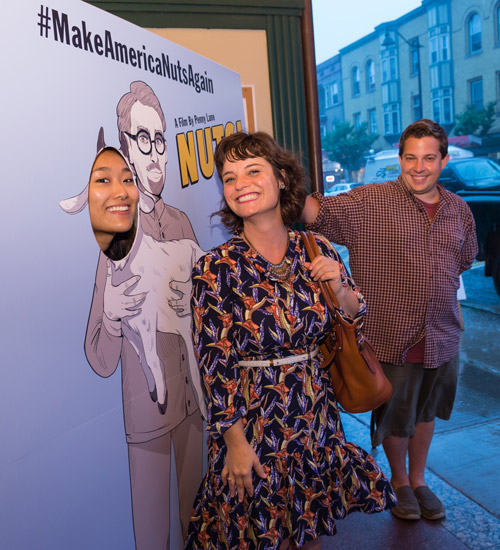
PHOTO BY MARK DIORIO. Penny Lane at the Hamilton showing of NUTS!, which premiered at the 2016 Sundance Film Festival, where it won a special jury prize for editing. Lane screened NUTS! at the Hamilton Theater and participated in a Q&A as part of Colgate’s Living Writers series last fall.
REEL EXPERIENCE IN THE CLASSROOM
“It is much, much easier not to make films,” Penny Lane wrote in a recent Filmmaker magazine article. “[I tell my students] the best thing they can learn is how to fool themselves that their great idea will be ‘easy, fun, and fast,’ because that’s what will convince you to say yes, and then to learn to cope when it’s none of those things.”
Lane’s statement is tongue in cheek, but she does spend a lot of time with students on creating art “that motivates them — makes them want to stay up working on [it] all night because it’s fun,” she said.
Whether she’s laying the groundwork in her intro to video art course or overseeing senior studio art projects, Lane encourages her students to base their work on “genuine interests, not what you think your professor wants you to do.”
Students have also benefited from real-world experience with Lane — she hires them as research assistants on her own projects. “As a result, our students have gained tremendous insight into documentary practice, aesthetics, and ethics, as well as the filmmaking process more generally,” said film and media studies professor Mary Simonson. Furthermore, because of Lane’s connection to the world of documentary filmmaking and her presence on the film festival circuit, “she has a keen sense of the most exciting new work that’s being made, [so] we’ve been able to invite a wide range of independent filmmakers to campus,” Simonson added. “[It] has significantly enriched our film and media studies curriculum.”



